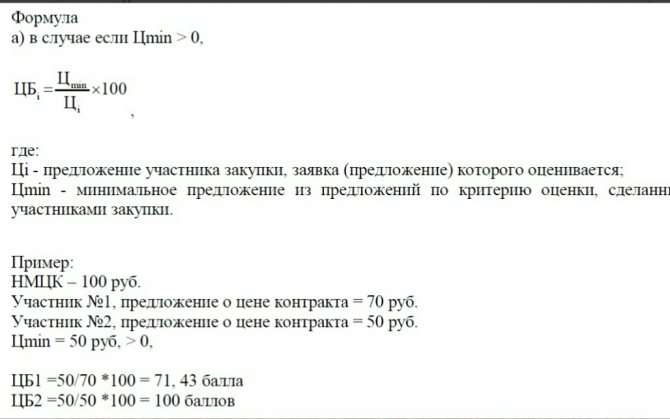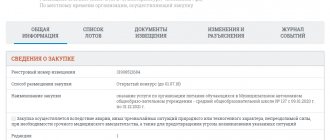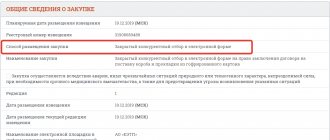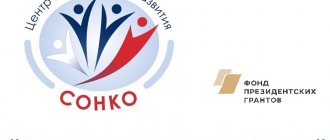Non-cost criteria
2.1 Qualification of tender participants in electronic form (including work experience related to the subject of the contract; business reputation (as a quantitative indicator); human resources (quantity and (or) qualifications); availability of financial resources) 502.1.1 Experience of the participant in the successful delivery of goods , performance of work, provision of services of a comparable nature and volume 502.1.2 Business reputation of the procurement participant 302.1.3 Human resources 102.1.4 Availability of financial resources (absence of tax debt) 10Evaluation of applications based on non-cost criteria
The customer should independently formulate what exactly is meant by the quality of work or the qualifications of the participant. Often, within the framework of one criterion, several indicators are included in the documentation. Non-cost criteria for evaluating applications include, for example:
- Availability of a quality control system.
- Environmental events.
- Technology of work execution.
- Occupational health and safety measures.
The qualifications of a procurement participant can be assessed according to the following group of indicators:
- Personnel qualifications : certificates and permits, portfolio and scientific degree.
- Participant experience : number of signed contracts for similar work.
- Availability of necessary equipment.
- Business reputation of the company in the market : the number of positive reviews, the presence of letters of gratitude, participation in various ratings, etc.
- Availability of financial resources : assessment of the financial stability of the supplier based on financial statements.
The criteria for assessing non-cost parameters must have a numerical expression. That is, the important fact is not just the availability of equipment, but the number of units of tools and vehicles. Not just work experience is important, but also the number of contracts with a similar subject of purchase.
The customer must document its compliance with the non-cost criteria. To do this, he attaches to the application copies of work records, diplomas, contracts, etc.
The customer assigns its own significance coefficient to each non-cost criterion. The sum of all criteria must equal one.
For example, the qualification criterion includes such indicators as “work experience” (significance criterion – 0.6), “business reputation” (criterion – 0.2), “availability of financial resources” (criterion – 0.2). In total, these criteria give one.
Application evaluation procedure:
The evaluation and comparison of applications is carried out by a commission in order to identify the best conditions for the execution of the contract in accordance with the above criteria.
Evaluation and comparison of applications according to the above criteria is carried out in accordance with the evaluation procedure defined by the Rules.
In accordance with the Evaluation Rules, the following terms are used:
- “evaluation” is the process of identifying, in accordance with the conditions for determining suppliers (contractors, performers) according to evaluation criteria and in the manner established in the procurement documentation in accordance with the requirements of the Evaluation Rules, the best conditions for the execution of the contract specified in the applications (proposals) of procurement participants, which were not rejected;
- “significance of the evaluation criterion” - the weight of the evaluation criterion in the set of evaluation criteria established in the procurement documentation in accordance with the requirements of the Evaluation Rules, expressed as a percentage;
— “evaluation criterion significance coefficient” — the weight of the evaluation criterion in the set of evaluation criteria established in the procurement documentation in accordance with the requirements of the Evaluation Rules, divided by 100;
— “rating of an application (proposal) by evaluation criterion” - a score in points received by a procurement participant based on the results of evaluation by evaluation criterion, taking into account the significance coefficient of the evaluation criterion.
The final rating of the application (proposal) is calculated as the sum of the ratings for each criterion for evaluating the application (proposal).
The winner is the procurement participant whose application (proposal) is assigned the highest final rating. The application (proposal) of such a procurement participant is assigned the first serial number.
1. Cost evaluation criteria:
1.1. Contract price.
- Contract price – significance 50%. Significance coefficient – 0.5.
Evaluation procedure:
The number of points awarded according to the evaluation criterion “Contract price” (CBi) is determined by the formula:
CBi = Cmin/Ci x 100
Where:
CI - proposal of the procurement participant whose application (proposal) is being evaluated;
Tmin - the minimum offer from the proposals for the evaluation criterion made by the procurement participants;
If Cmin<0, CBi is determined by the following formula:
TsBi = (Tsmax - Tsi) / Tsmax x 100
Where:
Tmax is the maximum offer among the proposals based on the evaluation criterion made by the procurement participants.
Failure to provide information is scored 0 points.
- II. Non-cost criteria for evaluating applications:
Evaluation principle
The customer must specify the procedure for evaluating applications in the procurement documentation. It is necessary to indicate which criteria he chose, as well as their significance. There must be at least two criteria , and one of them (the main one) is the contract price .
The significance of price criteria is set in such a way that their total values add up to 100%. For non-price criteria, you can also set an indicator of significance and prescribe the order in accordance with which it will be assessed.
The significance of the criterion is measured in points - each of them is assessed on a 100-point scale. When each criterion is assessed separately, the scores are summed up. The result is an overall application score, according to which they are ranked. The first place goes to the application with the most points.
The resolution also defines the maximum significance of criteria of each type. Thus, the following significance has been established for goods
- for cost criteria - minimum 70%;
- for non-cost criteria - maximum 30%.
For services and works the numbers are slightly different:
- significance of cost criteria - minimum 60%;
- significance of non-cost criteria - maximum 40%.
How to calculate points based on cost criteria
Let's look at how valuation occurs based on cost criteria, using the example of a contract price . The minimum price proposal contained in the received applications is taken - it acts as a kind of standard. This value is then divided by the price of the application that is being evaluated and multiplied by 100. This will be the number of points for this criterion. The formula is:
Where:
- CI – proposal of the procurement participant whose application is being evaluated;
- Цmin – the minimum offer from the proposals for the evaluation criterion made by the procurement participants;
Assessment according to the criterion “ life cycle cost” is carried out according to the same principle.
Formulas for assessment based on other cost criteria are given in Resolution No. 1085 .
How is assessment carried out using non-cost criteria?
Unlike an assessment based on cost criteria, where everything is expressed in numbers, there is much more subjectivity in non-cost criteria. The commission evaluates each characteristic and assigns points. Next, the average value is calculated. Then the assessment is calculated based on the non-price criterion, the formula of which is given in the above-mentioned resolution No. 1085:
NCBi = KZ x 100 x (Kmin / Ki)
Where:
- KZ - indicator significance coefficient (if one indicator is used, KZ = 1);
- Kmin - the minimum offer from the proposals for the evaluation criterion made by the procurement participants;
- Ki - proposal of the procurement participant whose application (proposal) is being evaluated.
Non-cost evaluation criteria:
2.1. Qualification of procurement participants.
The significance of the evaluation criterion is 50%. Significance coefficient – 0.5.
Maximum points: 100.
The order of evaluation according to the criterion:
The number of points assigned to an application according to the “Participant Qualification” (KVi) criterion is determined as the sum of the products of the number of points assigned to the application for participation in the competition for each criterion indicator and the significance of each indicator according to the following formula:
KVi = KVai x 0.5 + KVbi x 0.3 + KVci x 0.1+ KVdi x 0.1
Where:
KVai - the number of points assigned to the application for participation in the competition, according to the indicator “Participant’s experience in successfully performing work of a comparable nature and volume”;
KVbi - the number of points assigned to the application for participation in the competition according to the indicator “Business reputation of the procurement participant.”
КVсi — the number of points assigned to the application for participation in the competition according to the “Human Resources” indicator;
KVdi - the number of points assigned to the application for participation in the competition according to the indicator “Availability of financial resources (absence of tax debt).”
Failure to provide information is scored 0 points.
Criteria for evaluating applications for participation in the competition
All criteria for evaluating applications for participation in the competition under 44-FZ are divided into two large groups. These are cost characteristics and non-cost characteristics. Cost characteristics include:
- Contract price.
- Expenses for the operation and repair of goods , use of the results of work and provision of services.
- Life cycle cost, cost of goods, services, work, operation, repair, disposal . This criterion is taken into account if it is intended not only to supply goods, but also consumables, etc.
- Proposal regarding the amount of the customer's expenses under the energy service contract.
Often, the customer is limited only by the price of the product to evaluate applications for participation. But sometimes he needs to purchase equipment. The cost of repairs and the purchase of consumables will largely depend on the equipment model proposed by the supplier.
For the purpose of budgetary savings, the customer indicates that a higher rating is assigned to the supplier who can offer the lowest cost in terms of operating costs.
To identify the most advantageous offer, the customer can set such evaluation parameters as a list of operating costs (equipment repair and supply of consumables, etc.), a unit of measurement for operating costs and product service life.
Non-cost characteristics are:
- Qualitative, functional, environmental characteristics of goods, services and work.
- Qualification level of the procurement participant.
- Availability of equipment by the participant.
- Positive reputation.
- Product compliance with environmental standards.
The winner of a procurement in the form of a competition is not the participant with the lowest price, but the one who offered the best terms for the execution of the contract. Applications for participation in an open competition are always assessed according to at least two criteria, one of which is price.
At the same time, according to Government Decree No. 1085, limit values are established for each of the criteria. This:
- 70% for cost criteria when supplying goods;
- 60% – when ordering works and services.
For non-cost criteria, these limit values are 30% for goods and 40% for works and services. Specific maximum values of cost and non-cost criteria are given in the table.
| Subject of the concluded agreement | Maximum price significance, % | Limit value of non-cost criteria, % |
| All items not listed | 70 | 30 |
| Works and services not included in the list | 60 | 40 |
| Rescue work | 40 | 60 |
| Restoration work on objects with cultural heritage status | 40 | 60 |
| Legal, educational, medical services | 40 | 60 |
| Regulatory documents in the field of education (development) | 40 | 60 |
| Expert services | 30 | 70 |
| Information systems technical support work | 30 | 70 |
| Film distribution services | 20 | 80 |
| R&D | 20 | 80 |
| Services of artists and directors | 20 | 80 |
| Creation of works of art, architecture, literature | 0 | 100 |
In exceptional cases, the customer may specify in the requirements additional criteria for evaluating applications that are not cost or non-cost. They may be required when purchasing technically complex goods and services.
Criterion indicators:
2.1.1. “The participant’s experience in successfully delivering goods, performing work, and providing services of a comparable nature and volume.” Significance coefficient – 0.5. Maximum points: 100.
Contents of the indicator:
The customer will evaluate the participant’s proposal for the amount of contracts/agreements successfully executed by the procurement participant (hereinafter referred to as the contract) for the period from November 17, 2017 to the deadline for submitting applications for participation in this competition.
Services of a comparable nature, for assessment purposes, are recognized as the performance of work/provision of services for cleaning buildings and territories concluded in accordance with the provisions of Federal Law dated 04/05/2014 No. 44-FZ “On the contract system in the field of procurement of goods, works, services for the provision of public and municipal needs" or the Federal Law of July 18, 2011 No. 223-FZ "On the procurement of goods, works, services by certain types of legal entities."
The amount of contracts/agreements successfully executed by a procurement participant is calculated in aggregate for all submitted contracts/agreements of a comparable nature, and not for each contract/agreement separately.
The experience of the procurement participant in successfully completing work of a comparable nature is confirmed by the procurement participant providing as part of the application for participation in an open tender:
- a copy of the previously executed contract(s)/agreement(s) for the performance of work of a comparable nature for state and municipal customers.
- a copy of the act(s) of acceptance of work performed, confirming(s) the acceptance of work performed for state or municipal customers for the execution of the contract/agreement.
Copies of these documents must be submitted in full with all annexes that are an integral part of them, including additional agreements.
In the event that a participant in the competition does not submit documents confirming qualifications in the order specified above, and when reviewing these documents, the Customer has difficulties in attributing acts of work performed to certain contracts/agreements and/or difficulties in attributing a contract/agreement to certain acts of work performed, the Customer does not take such documents into account when assessing.
Contracts/agreements submitted by the procurement participant, the execution of which is not documented, are not taken into account in the assessment.
Submitted documents must be in the form of readable copies, on which the necessary information is visible, including dates, signatures, seals, and electronic signature. The participant's proposal regarding the submitted information that does not meet the specified requirements will not be accepted for evaluation.
The customer has the right to request from the relevant authorities and organizations information about the successful completion of work on the procurement participant’s execution of the contract/agreement without the application of penalties (fines, penalties) to such participant.
The customer has the right to check information about the successful completion of work under the contracts/agreements provided by the procurement participant without applying penalties (fines, penalties) to such participant in the register of contracts/agreements on the Official website of the unified information system in the field of procurement on the Internet information and telecommunications network (https:/ /zakupki.gov.ru)
Contracts/agreements executed by a procurement participant with the use of penalties (fines, penalties) are not accepted for evaluation.
How are non-cost criteria assessed?
For example, the customer evaluates applications according to “accounts payable”. In this case, the lower the value, the higher the score the participant receives. Two applications were received for participation in the competition:
- Application No. 1 – amount of accounts payable – 100 thousand rubles.
- Application No. 2 – amount of accounts payable – 150 thousand rubles.
The first participant will receive 100,000 / 100,000 * 100 = 100 points.
Second – 100,000 / 150,000 * 100 = 66.7 points.
The significance criterion for this parameter is set as 0.4. This means that participants will receive:
- First participant – 40 points (100 * 0.4).
- Second participant – 26.7 points (66.7 * 0.4).
Applications regarding non-cost criteria may be assessed differently. For example, the customer established a requirement for experience in implementing at least 10 similar contracts. Then all participants who implemented 10, 20, 40 similar contracts will receive the same number of points.
The customer can also introduce a rating scale when holding an open competition. In them, the customer sets the ranges of possible values and the number of points that are awarded for falling within a certain range.
For example, if the customer takes into account the number of personnel, the scale could be as follows:
- Up to 10 employees – 0 points.
- From 10-50 employees – 30 points.
- From 50-100 employees – 60 points.
- More than 100 employees – 100 points.
The number of points is calculated as follows:
| Indicator value | Number of points |
| Cumulative experience in agreements/contracts for a total amount of at least 95% of the initial (maximum) price of the contract for the right to enter into which a competition is held | 100 |
| Cumulative experience in agreements/contracts for a total amount of at least 75% of the initial (maximum) price of the contract for the right to enter into which a competition is held | 60 |
| Cumulative experience in agreements/contracts for a total amount of at least 50% of the initial (maximum) price of the contract for the right to enter into which a competition is held | 30 |
| Cumulative experience in agreements/contracts for a total amount of at least 25% of the initial (maximum) price of the contract for the right to enter into which a competition is held | 10 |
Failure to provide information is scored 0 points.
The procedure for assessing the indicator:
| № | Name of indicator (subject of assessment) | Number of points |
| 1 | 0 positive reviews, thanks, certificates, diplomas, recommendations from the Customer(s) | 0 |
| 2 | from 1 to 2 (inclusive) positive reviews, thanks, certificates, diplomas, recommendations from the Customer(s) | 25 |
| 3 | from 3 to 4 (inclusive) positive reviews, thanks, certificates, diplomas, recommendations | 50 |
| 4 | from 5 to 6 (inclusive) positive reviews, thanks, certificates, diplomas, recommendations | 70 |
| 5 | from 7 or more positive reviews, thanks, certificates, diplomas, recommendations from the Customer(s) | 100 |
Failure to provide information is scored 0 points.
A score of 0 points for the indicator is assigned to a procurement participant whose application does not contain positive feedback from customers for the work performed/services provided, or Documents that do not have clear details are presented, or documents are submitted from individuals.
2.1.3. "Human Resources". Significance factor – 0.1. Maximum points: 100.
Contents of the indicator:
This indicator assesses whether the procurement participant has employees planned to be involved in the provision of services under the contract.
Data on the procurement participant’s availability of employees planned to be involved in the provision of services (administrative personnel are not taken into account) under the contract is confirmed by the presence in the application of copies of employment contracts and (or) civil contracts.
The procedure for assessing the indicator:
| № | Name of indicator (subject of assessment) | Number of points |
| 1 | There is no data or the participant has less than 5 (five) employees planned to be involved in the provision of services under the contract | 0 |
| 2 | The participant has at least 5 (five) employees planned to be involved in the provision of services under the contract | 10 |
| 3 | The participant has at least 10 (ten) employees planned to be involved in the provision of services under the contract | 30 |
| 4 | The participant has at least 15 (fifteen) employees planned to be involved in the provision of services under the contract | 60 |
| 5 | The participant has at least 20 (twenty) employees planned to be involved in the provision of services under the contract | 100 |
Failure to provide information is scored 0 points.
Extract from the protocol of consideration of applications, calculation of points.
You might be interested in:
- CRITERIA FOR EVALUATING APPLICATIONS FOR PARTICIPATION IN THE COMPETITION
- EVALUATION OF APPLICATIONS
- COMPETITION FOR 44-FZ. CONDUCT AND PARTICIPATION IN THE COMPETITION
- PREPARATION OF APPLICATIONS FOR PARTICIPATION
- PROCEDURE FOR CONSIDERATION OF THE FIRST PARTS OF APPLICATIONS FOR PARTICIPATION IN AN ELECTRONIC AUCTION
- ON APPROVAL OF THE RULES FOR EVALUATING APPLICATIONS AND FINAL OFFERS OF GOODS PURCHASE PARTICIPANTS
- REJECTION OF TENDERS
- Decree of the Government of the Russian Federation N 1085
- PARTICIPATION IN TRADES
- Reasons for rejecting participants' applications
Contract price and life cycle contract cost
The first and most important criterion when evaluating applications for participation in a competition under 44-FZ is the contract price and life cycle cost. The lower the value of this indicator, the higher the score the supplier receives.
Sometimes bidders, wanting to pay for the opportunity to enter into a contract, set the price below zero. This does not contradict the law and significantly increases the chances of getting the maximum score and winning the competition.
This criterion is calculated as follows:

Then the results obtained should be multiplied by the significance coefficient, according to the Appendix to PP No. 1085.
Calculation example:
Let's say KZ = 0.7.
In this case, the rating of the first supplier is 71.43 * 0.7 = 50.
The rating of the second supplier is 100 * 0.7 = 70.









